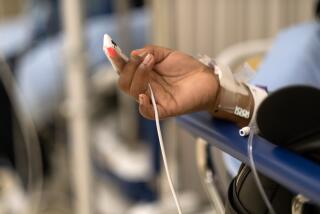Youth’s Case Highlights How Exposure Leads to Infection
- Share via
The medical odyssey of 14-year-old Jeff Thornton, who died after developing gangrene from frostbite, is a testament to how exposure to severe cold can lead to infection.
Exposure to cold shrinks blood vessels in the feet and hands, pinching off circulation and leaving the limbs without enough blood flow to fight infection in those areas. Tissues also die because of the lack of blood, providing a fertile breeding ground for bacteria. Some of the bacteria are very difficult to control, and some are resistant to antibiotics. The build-up of those toxins can spread through the body and shut off important functions, including the heart, experts say.
In Thornton’s case, the infection apparently was treated with a combination of antibiotics and oxygen enrichment. The youth’s placement in a hyperbaric chamber was intended to kill the bacteria with high doses of oxygen absorbed through the skin.
Loma Linda University Medical Center is sure to face questions of whether Thornton was treated early or aggressively enough for the infection, which he might have picked up during his wanderings in the mountains or later in the hospital. Medical literature suggests that two-thirds of such septic shock cases arise after hospitalization.
Gangrene occurs when infection gets out of hand.
Antibiotics can usually kill anaerobic bacteria, but if blood flow is impaired, they cannot reach the gangrenous tissues. In such cases, physicians often use what is called hyperbaric oxygen therapy, in which the patient is placed in a sealed chamber containing 100% oxygen at two to three times atmospheric pressure. The goal is to force oxygen into the tissues to kill off as many of the bacteria as possible.
Anaerobic bacteria release toxins into the blood that can damage blood vessels and internal organs. Capillaries in the lung become impaired, making it difficult for the patient to get enough oxygen--producing what is known as adult respiratory distress syndrome. This effect is magnified by the toxins’ effect on the heart, which further reduces blood flow through the lungs.
When septic shock occurs, body systems shut down and, eventually, the heart stops beating.
Hospital bacteria that cause septic shock often sneak into the body through catheters, drainage tubes and IVs.






